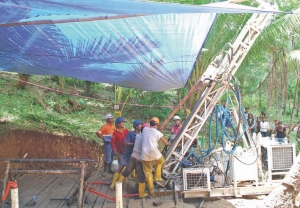VANCOUVER — With 15 gold and copper projects on the go in Indonesia, as well as three uranium projects in Mongolia, East Asia Minerals (EAS-V, EAIAF-O) has been churning out a lot of news over the past few months.
The company’s main focus at the moment is the Sangihe project, located on southeast Sangihe Island in Indonesia. The project hosts numerous epithermal and porphyry gold and copper prospects that were discovered and explored in the 1980s.
The Binebase target sits at the north end of the property. Just over 1 km to the south sits Bawone; East Asia is currently investigating whether the area in between, called Bawone North, is also mineralized. Some 400 metres southwest of Bawone sits the Brown Sugar target, an area that boasts historical high-grade gold and silver samples. Several kilo-metres to the south lie the Sedi and Kelapa targets, both of which have delivered high-grade trench results.
At Bawone, shallow drilling by previous explorers produced several strong intersections. During 2007, East Asia drilled seven holes for 1,000 metres and results indicated the presence of a near-surface mineralized zone up to 80 metres thick. For example, hole BOD-01 intersected 95 metres grading 2.15 grams gold per tonne, 11 grams silver and 0.41% copper from 30 metres depth.
At Binebase, 1.2 km north within the same 3-km-long, 600-metre-wide structural corridor, East Asia started by resampling historic trenches and was rewarded with strong results, including 32 metres of 4.18 grams gold and 38 grams silver. More recently drill results have demonstrated that the target hosts significant epithermal gold mineralization from surface. On the west side of the zone, hole BID- 13 cut 36 metres grading 4.03 grams gold and 188.28 grams silver from 8 metres depth. Nearby, hole 14 intersected 96.2 metres grading 1.3 grams gold and 48.25 grams silver from surface. And close to the centre of the target, hole 15 returned 45 metres from surface grading 1.52 grams gold and 80.03 grams silver.
To test the continuity of mineralization between Binebase and Bawone, the company punched a hole 110 metres south of Binebase. The core from hole BID-16 returned 30 metres from surface grading 2.72 grams gold and 6.74 grams silver, including 15 metres of 4.7 grams gold and 1.92 grams silver, followed by 108 metres grading 0.36 gram gold and 7.75 grams silver from 76 metres depth. East Asia says the results support the idea that Binebase and Bawone connect along a shared structure, as do geophysics from the 1980s that indicated Bawone mineralization extended for 450 metres towards Binebase.
Mineralization at the two targets is of the same style, occurring as sub-parallel zones associated with strike-slip faults and as strata-bound bodies. Host rocks are generally andesitic crystal lithic tuffs and breccias that have been variably altered. Gold and silver occur as massive and stockwork zones of pyrite, enargite, chalcocite, and arsenian pyrite.
The Sangihe property is just one of East Asia’s Indonesian projects. The company is currently exploring three epithermal gold zones within the Abong Corridor on the Barisan 1 property and four classically zoned, partially explored porphyry copper-gold systems on the Barisan 2 property.
The Abong Corridor is a 3 by 1.5-km stretch of anomalous surface gold mineralization first identified in the mid-1990s. East Asia is focused in on three zones within the low-sulphidation epithermal corridor. The Jasperoid zone, at the southeast end of the stretch, hosts a resource (not compliant with National Instrument 43-101) of 40 to 60 million tonnes grading 1 to 1.5 grams gold. In 2007, East Asia completed mapping and channel sampling; the average gold grade from 420 channel samples, generally about 1 metre long, was 1.24 grams gold.
In 2008, the company started drilling at Jasperoid and results are starting to outline a shallowly dipping, near-surface zone of epithermal mineralization more than 500 metres long. Hole ABD-05 intersected 2.32 grams gold over 8 metres from 1 metre below surface; hole ABD-01 returned 2.81 grams gold over 10 metres from 21 metres; and hole ABD-07 hit 2.24 grams gold over 12 metres from surface.
The Bintang prospect sits at the northwest end of the Abong Corridor. In the mid-1990s, previous explorers outlined a surface-exposed breccia zone 750 by 450 metres in size. East Asia’s trench sampling has added to that a smaller area showing significant gold potential to the northwest, such as an 8-metre trench sample that returned 12.11 grams gold. Mineralization occurs in oxidized collapse breccias that are cut by late vuggy quartz-sulphide veins. Drilling is planned for the near future.
And just 600 metres southeast of Bintang, the Fikri prospect returned trench sampling results as good as 4.75 grams gold over 16 metres. The style of mineralization is very similar to that found at Bintang. Drilling at Fikri started in December and East Asia plans to calculate a resource estimate by year-end.
At Barisan 2, three of the four porphyry-style gold-copper targets host non-NI 43-101-compliant resources and the fourth has strong historic trench results. To date, East Asia has focused on the Upper Tengkereng prospect, outlining the porphyry over an area measuring 600 by 400 metres. The company plans to drill its Barisan 2 prospects in 2008.
And despite divesting several major uranium projects through the $83-million sale of East Asia Minerals Energy, a wholly owned subsidiary, to French nuclear energy giant Areva in 2007, East Asia retained the most advanced projects in its uranium portfolio. The company’s three uranium projects — Ingiin Nars, Ulaan Nuur, and Enger — are all in Mongolia.
East Asia recently traded at $1.75 in a 52-week trading range of 65-$2.95 and has 55.6 million shares issued.


Be the first to comment on "East Asia Minerals off and running in Indonesia"